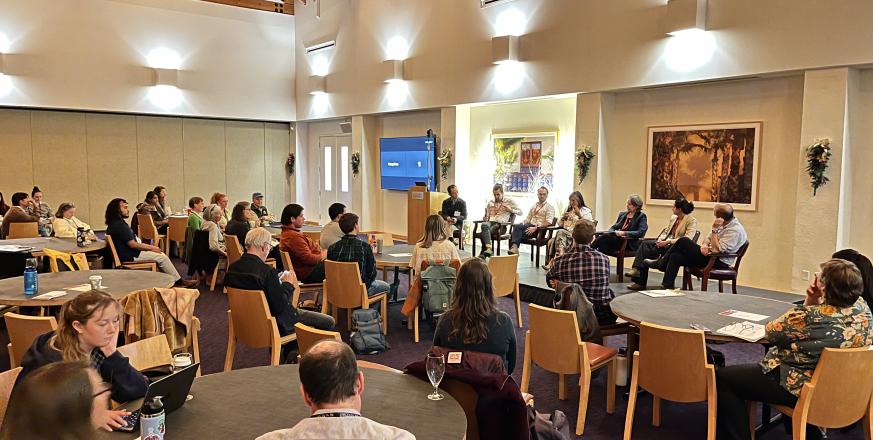Watershed Restoration Conference Inspires Future Research, Education, and Stewardship for Searsville Watershed Restoration Project

Day 1 panelist discussion at the Watershed Restoration Conference.
Jasper Ridge Biological Preserve Faculty Director Tad Fukami hosted the Watershed Restoration Conference on December 11-12, 2023. This event was organized by the Stanford Graduate School of Business (GSB) and Doerr School of Sustainability as part of a year-long conference series focused on identifying intersections and connections in sustainability between researchers and practitioners across multiple areas of study.
The conference topic emerged from an idea brainstormed by Jasper Ridge staff who are interested in learning from and engaging with experts on watershed restoration to support the ongoing Searsville Watershed Restoration Project. Professor Fukami then invited nine experts on watershed science, policy, and tribal engagement to speak on research and lessons learned from their experiences.

David Moreno-Mateos, Albert Ruhi, Anecita Agustinez, Sibyl Diver, Chhaya Werner, Robert Lusardi, and Tad Fukami. Speakers George Pess and Keith Parker joined remotely.
On the first day of the conference, speakers each presented to an audience of about 60 people. Speakers Anecita Agustinez, Tribal Policy Advisor from the California Department of Water Resources, Sibyl Diver, lecturer at Stanford University, and Ketih Parker, Senior Fisheries Biologist for the Yurok Tribe of California, shared their knowledge related to existing policies that can support Indigenous watershed governance, examples of developing research and policies initiatives within Indigenous communities, and a direct example from the ongoing Klamath dams removal project on how Tribal governance must be part of watershed restoration. Speakers Chhaya Werner, Assistant Professor at Southern Oregon University, and David Moreno-Mateos, Associate Professor at University of Oxford, shared their expertise on watershed restoration from a terrestrial point of view and from multiple synthesis and meta-analysis examples to investigate what “success” means across various temporal scales. Robert Lusardi, Assistant Professor at University of California Davis, Albert Ruhi, Assistant Professor University of California, Berkeley, and George Pess, NOAA Watershed Project Manager, stressed the importance of focusing on the life-history of species targeted for conversation (e.g. salmonids), the importance of diverse restoration projects for different habitats, and how the impact of novel flow regimes created by humans have on freshwater biodiversity, and ideas on how to mitigate the impact.
Throughout the day, several themes emerged which encouraged lively interaction among all participants. One theme highlighted the term “restoration” and opened a discussion that watershed restoration projects are not intended to restore to a specific state, but are rather restore for particular goals such as broad ecosystem function or specific fish passage conditions. These thoughts also connected to reframing restoration expectations from short term (days, weeks, months), to much longer term (years, decades, centuries), with an understanding that in the short term, timing of restoration activities can be very important, and this should be considered for long-term adaptive management with expected changes in stewardship strategies.
Another theme that emerged was about what language we use in these projects and how we connect with communities of interest. Speaker, Anecita Agustinez, brought up how “stakeholder” is not an appropriate term to use, especially when including Indigenous communities in decisions and planning because they are sovereign entities. Speaker Keith Parker, brought up not using the term “management” but rather “stewardship” because he does not see humans as separate from the land, but rather that humans are an integrated part of the land, and should be responsible stewards.
On the second day of the conference, the speakers were invited to join Stanford staff from Jasper Ridge and LBRE (Lands, Buildings, and Real Estate) who are involved in the Searsville Watershed Restoration Project (SWRP). The day started with a joint presentation by Karla Smith, SWRP project manager, and Sheena Sidhu, JRBP Stewardship Scientist, who covered technical details about the SWRP and highlighted research opportunities. This opened the floor to an active discussion about potential research, education, and outreach to connect SWRP stewardship to communities of interest which include Stanford faculty, staff, Jasper Ridge docents, neighbors, Indigenous communities, and both upstream and downstream communities. The discussions and brainstorming continued as the group toured the dam and causeway with Jorge Ramos, JRBP Executive Director explaining the expected landscape changes and associated concerns related to responsible stewardship.
The conference ended with stronger relationships and commitments to stay connected and build on the great ideas and inspiration that emerged from the event as we continue to prepare for the Searsville dam modification project at Jasper Ridge.
To listen to a summary of the knowledge and discussion featured in this Watershed Restoration conference please visit the GSB website and click on the podcast.

Day 2 visit to Jasper Ridge Biological Preserve. The group stands on the causeway to discuss how the surroudning vegetation will be removed and will require stewardship once the Searsville dam is modified downstream.



